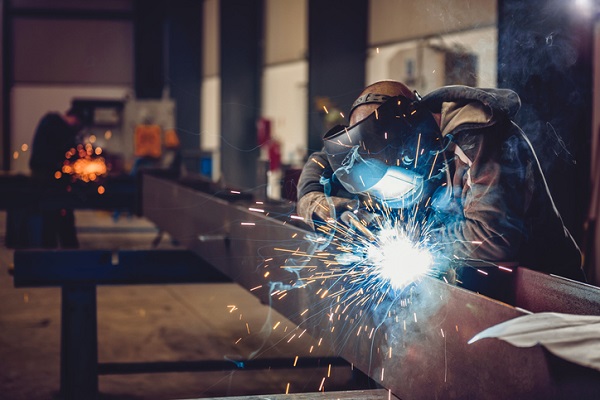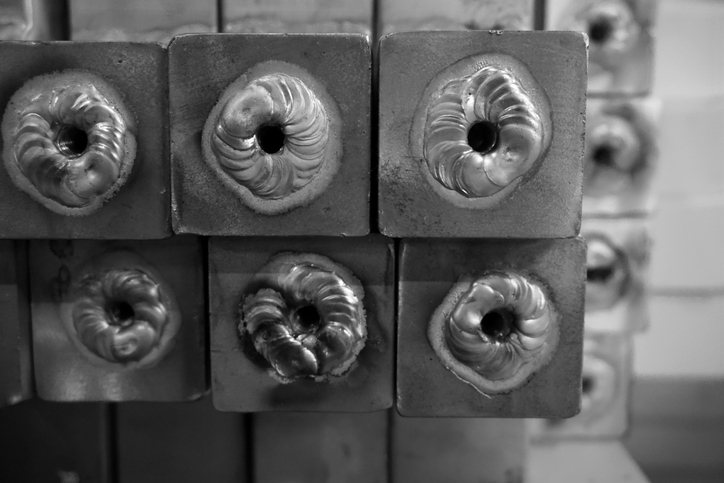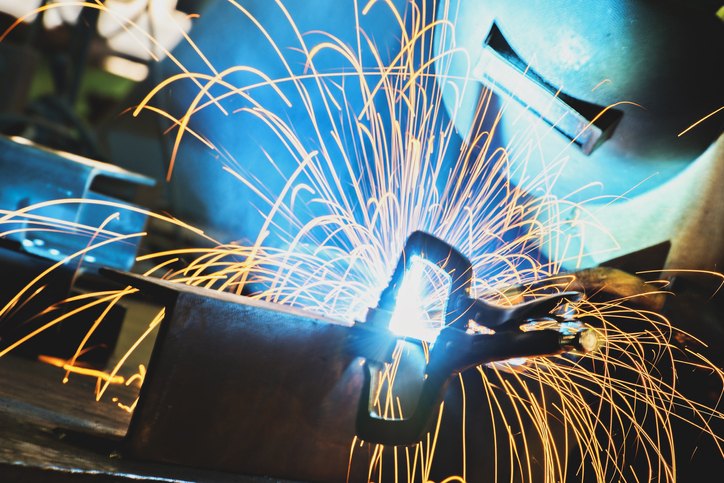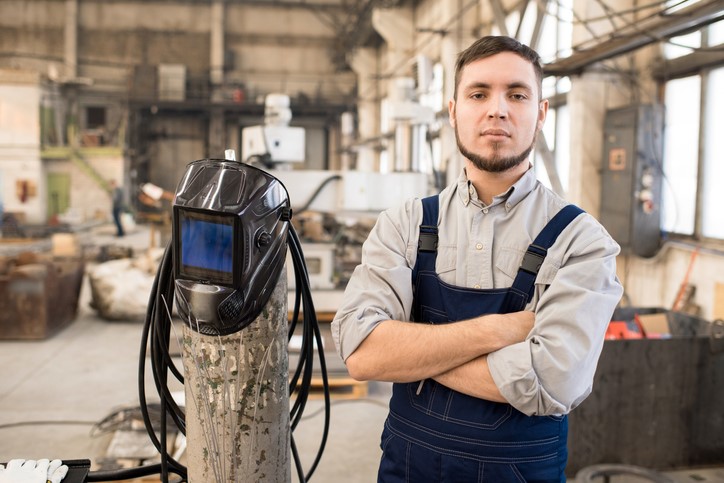Author: wpadmin
3 Challenges You Might Face in Your Welding Career, And How to Overcome Them
August 15, 2019
Welding is not only an incredibly rewarding field to be part of, but also helps showcase your ability to be strategic and maintain quality control. Like any industry, welding carries its own set of challenges, but they certainly aren’t unmanageable—in fact, they get progressively easier as you go along.
This is a great industry if you love working with your hands and aren’t afraid to tackle challenging situations head-on. If you’re looking for a new career in welding, here are three of the biggest challenges a welder can face, and how they can conquer them.
Welding Aluminum Has a Learning Curve, But it’s Easier Than You Think
Although it’s one of various types of metals you may encounter, aluminum is distinctive in terms of techniques needed to properly weld it. Aluminum has a varied chemical composition, a high thermal conductivity, and a low melting point—meaning that it can be broken, cracked, or warped easily, and burn-through can also happen.
It also runs the risk of discolouration, for which you need to make sure you’re using the correct filler metal to prevent magnesium oxide from building up while welding. With cracking and breaking, it’s best to use a filler metal with less of a heat-sensitive chemical composition, as well as making sure pulse capabilities are part of your gas metal arc welding (GMAW) process.

Learning Part Fit-Up Best Practices Throughout Your Welding Career
One of the biggest skills to have as a welder is the ability to problem solve. Furthermore, you will likely be taught how to read specifications and blueprints while studying for your welding diploma, so attention to detail is also essential. Therefore, it’s essential that you maintain quality control by ensuring parts fit with each other according to specifications.
Make sure the pieces are cut and fit proportionately, as it can be tedious to weld successfully if there are major gaps, or the parts don’t fit well enough. You must also be careful in preparing the joints, and you can do this by cleaning all paint, oil, and other matter from the edges, as well as cutting bevels properly and making sure the surfaces of the joint are smoothed out.
Learning How to Weld in Different Positions
In your welding career, you may weld parts in overhead, flat, horizontal, or vertical positions. Each requires a certain technique to do properly. The flat position is arguably the easiest, as it involves welding the uppermost side of the joint while the face remains horizontal and molten metal travels downward. The horizontal position involves welding material on the upper side of a horizontal surface against a vertical one, and vertical welding is where the weld’s axis and plate lie in a vertical position. Overhead welding is considered the most complex position, as it involves welding from the underside of a joint.

The best ways to tackle the latter three welds are to point the flame up at a 45 degree angle to the plate during a vertical weld, so that the lower parts go against the force of gravity. Horizontal welding needs the tack weld and plates aligned at both ends, so heat can move evenly toward both sides of the joint. As for overhead welding, make sure the weld puddle is small so the deposited metal doesn’t sag or drop on the plate.
Do you want to enroll in welding courses?
Contact North American Trade Schools to learn more about our Welding Technology diploma program!
 It’s that time of year again, where summer is in full swing and air conditioning units become our best friends. However, you might not know that there are a number of ways you can help someone’s home have the most optimal temperature possible, and the way it’s being done is getting increasingly modernized. Just as technology continues to evolve, so do trends in the HVAC industry.
It’s that time of year again, where summer is in full swing and air conditioning units become our best friends. However, you might not know that there are a number of ways you can help someone’s home have the most optimal temperature possible, and the way it’s being done is getting increasingly modernized. Just as technology continues to evolve, so do trends in the HVAC industry.
While you may already be familiar with trends such as smart thermostats, digital zoning, geothermal/solar HVAC systems, and DeVAP, the breadth of HVAC technology actually goes even further than one might think. In fact, it’s an industry that’s modernizing in multiple areas, and these are just a few examples. Here are four trends you need to know about if you’re studying for a career in HVAC.
1. Smart HVAC: A Tool You’ll Probably See Down the Road in Your HVAC Career
No, smart technology isn’t just for your phone. The HVAC world has been experimenting with ways to make air conditioning more efficient and future-forward. Using technology such as mobile apps, motion sensors, and even thermostats, smart HVAC is increasingly becoming a trend in the industry, with technology already available to control an HVAC system remotely. Some HVAC systems and smart thermostats can even alert you about necessary maintenance. Considering how often HVAC systems can break down, this technology is ideal for those looking to modernize their home — and a fascinating tool for those in an HVAC career, as well.
 Smart technology has increasingly become a common presence in the HVAC world
Smart technology has increasingly become a common presence in the HVAC world
2. HVAC Technicians Know Duct Sealing is Effective and Simple
Thanks to companies like Aeroseal, this technology may not seem too futuristic in nature, but is no less impressive. As ductwork can start to become cracked and/or worn out with time, duct sealing can help solve the problem to avoid affecting the performance of your HVAC system — or worse, leakages. Through a water-based substance being sprayed onto the ductwork, it works to seal holes and cracks in vents and air ducts. In other words, it can stop ducts from leaking and humidity from entering your home, all while your energy bill starts tumbling down.
3. Hot Water Recirculating Systems: A Plumbing System You’ll See as an HVAC Technician
Here’s a technology that can go right under your kitchen sink and save you time as well. By moving hot water quickly from a water heater to a faucet, hot water recirculating systems move water without waiting for it to rise to warmer temperatures, and without the need for low water pressure. Often being activated by a thermostat, the hot water recirculating system is also known for its capacity in saving water, as some types of recirculating systems can save up to 15,000 gallons of water per year.
 HVAC technology can often be controlled remotely from a smartphone
HVAC technology can often be controlled remotely from a smartphone
4. Work on 3D Printed Air Conditioners During Your Career
You might be dealing with some odd shapes and sizes if you want to become an HVAC technician. Using a 3D scanner and computer-designed 3D model, you can make a digital copy of an object to build and use as an air conditioner, which then soaks water like a sponge, letting air pass through it. As a result, water evaporates and the air becomes cooler. Users can get creative with customizing it as well, as they can configure parts and its design to fit their needs. These printers are so impressive that the very first one was sold in China in 2015 for around 40,000 yuan (or more than $7,600 today in Canadian dollars).
Looking to study at an HVAC college?
Contact North American Trade Schools to learn more about our HVAC Technician diploma program!
 Welding is facing a serious labour shortage as many Baby Boomers retire and not enough younger workers line up to replace them. With Millennials (born roughly between 1980 and 1995) now firmly in the workforce and Generation Z (born between 1995 and 2002) following closely behind, many employers know that attracting these young workers to the welding profession is essential.
Welding is facing a serious labour shortage as many Baby Boomers retire and not enough younger workers line up to replace them. With Millennials (born roughly between 1980 and 1995) now firmly in the workforce and Generation Z (born between 1995 and 2002) following closely behind, many employers know that attracting these young workers to the welding profession is essential.
The good news is that there are plenty of reasons why welding is a great career choice for today’s young people. In fact, a career in welding aligns extremely well with what Millennials and Gen Zs are looking for in a career. Here’s how.
A Welding Apprenticeship Is a Great Way to Learn New Skills from the Pros
Millennials and Gen Zs are accustomed to disruption and they know they need to learn new skills to stay competitive in the workplace. However, they differ in how they go about learning those skills. While Millennials tend to be independent and like to forge their own paths, Gen Zs tend to respect authority and want to learn from their elders.
The career path to becoming a welder is likely to appeal to both Generation Z and Millennials who are eager to learn new skills. After acquiring training at school, would-be welders complete an apprenticeship with a more experienced welder and learn on the job. This means that Gen Zs appreciate learning under the direction of a professional, while Millennials enjoy the flexibility of being able to learn while earning money on the job.
 Both Millennials and Gen Zs are eager to learn new skills to stay competitive
Both Millennials and Gen Zs are eager to learn new skills to stay competitive
Welding Careers are Currently In Demand and Pay Well
Gen Z grew up watching their parents struggle with the fallout from the Great Recession and with student debt. As a result, they tend to be pragmatic and realistic about their careers. For example, for Gen Z, 44% say that salary is their main benchmark of success. While Millennials are more likely to value flexibility in their career, salary is also important for them. About 43% of Millennials who plan on leaving their jobs soon say they will do so because they are dissatisfied with pay.
The good news is that a young person who wants to become a production welder will have a career that is very well compensated. In Canada, the average hourly wage for welders is $28 per hour, or $58,000 annually, and welders have seen an impressive 13% increase in wages since 2010.
 Welders are in high demand and are well compensated for their work
Welders are in high demand and are well compensated for their work
A Welder Career Combines Passion with a Secure Job Outlook
Whereas Generation Z places a high premium on job security, Millennials are more willing to eschew the traditional office career and want one that provides them with meaningful work. A welder career is the rare type of job that can appeal to both of these desires.
Welders have opportunities to work in a variety of environments and to even transfer their skills to different parts of the country. While being a welder can sometimes be a physically demanding job, it is certainly not boring, which is likely to appeal to Millennials. At the same time, the demand for welders is strong and there is a consistent need for welding skills across the country in a variety of industries, which is the type of security that Gen Zs crave.
Do you want a new career that is in demand?
Contact North American Trade Schools to learn about our welder technician training.
4 Interview Tips That Can Help You Launch Your Electrician Career in Construction
July 16, 2019Are you hoping to start a career as a construction electrician? Great! Becoming a construction electrician means stepping into a hands-on career that is anything but your typical 9-5 office job.
Progressing along this career path, however, still means that you need to prepare for the interview process. Fortunately, there are plenty of tips and tricks you can use to approach your interview with confidence.
Here are a handful of tips for when you’re about to step into an interview.
1. Be Ready to Encounter Basic Questions During Your Interview
Employers looking to hire electricians and apprentice electricians—including in construction—may sometimes ask you basic questions like “What is the difference between a breaker and a fuse?”. Should they do this, it’s to filter out the candidates who have the best foundational knowledge of the profession from the ones who don’t. If necessary, brush up on your overall knowledge of electrician-related concepts before your interview so you go in able to explain them in as much detail as possible.
2. Prepare for Questions About Challenges and Troubleshooting
While being interviewed, you can expect employers to be curious about your problem-solving abilities. After all, problem-solving is important to this career path. Therefore, you might face questions about how you’d handle unexpected situations, and perhaps the specific process through which you would try to solve the problem.
They may also ask questions like, “What was the biggest challenge you’ve faced so far in your career?” or “What was the biggest mistake you’ve made at a job, and how did you atone for it?” Either way, interviewers will want to know how you overcame these obstacles.
3. Be Ready for Construction-Specific Questions
A number of electricians work in specialized fields, and construction electricians are definitely among them. As a result, you can expect questions specific to construction. For example, they might ask you what you love most about the field, or why you’re interested in the position. They may also ask you what you learned during your electrician training, and what you ultimately took out of the experience. In any case, these employers are going to want to know how your training and experience makes you an ideal fit for the position.
4. Answer Questions Honestly, and Be Yourself
Whether the questions are technical in nature, or if they’re simply about your past experiences in the field, be honest and descriptive in answering them. Even if you flub a question or wind up not getting the job, it’s still great practice for future interviews you may get later in your career as a construction electrician. Above all else, smile, be enthusiastic, and be respectful and professional throughout the process! After all, if you want to become a maintenance electrician, you can’t forget the basic tenets of how to ace a job interview in any industry.
Looking to start your electrician career in construction?
Contact North American Trade Schools to find out about our Construction & Maintenance Electrician Pre-Apprenticeship diploma program!
When building aircraft cabinets, considerations must be taken into account for safety reasons. Weight limits are expressed in maximum gross weight, which is the heaviest an aircraft can get while remaining safe. In addition to staying light enough, aircrafts also have to meet standards for flammability. Materials need to meet set flame and smoke retardant requirements. In the case of customized or private aircrafts, these standards are even more important, as the uniqueness of designs can affect whether or not they are up to code. Read on for some facts about aircraft cabinetmaking to see if you might like to work on them one day.
You Might Work with Composite Wood after Cabinetmaking School
Composite wood may come up in your career after your courses, especially if you choose to work on aircraft cabinets. Due to weight regulations, aircraft cabinets can’t be made out of regular, solid wood, or even plywood, as this adds too much weight to the craft. In its place, professionals use composite materials, which can have the appearance of solid wood but are much lighter. Cabinetmaking courses will prepare you to work with all kinds of wood. Almost every visible part of a commercial aircraft cabin is made of composite materials. Parts in an aircraft must also be very strong—composite or engineered wood provides structural integrity without adding deadweight to the plane.
Composite wood is usually used on aircraft cabinets to keep them lightweight
Hydrographics Might Be of Interest to Students in Cabinetmaking Courses
Aesthetics are important on cabinets, as you will know from the precision and high standards in your cabinetmaking training.
Depending on the finish desired, hydrographics can be an interesting approach to use on aircraft cabinets. Hydrographics can be used to decorate cabinets in the style of solid paint colours, brushed aluminum, or wood grain patterns—among many different options. The decorative film is applied using a hydro-dip method, and can be applied to almost any common shape in an aircraft interior. Hydro dipping involves floating the film on the surface of water, then dipping an object into it, causing the film to stick. The film meets flame and smoke retardant requirements and is also very thin and lightweight for use in planes.
Private Jets and Customization Can Keep Things Interesting in Your Career
Customized cabinets for aircraft can add variety to your day and present new challenges and learning opportunities. If you’re wondering whether you’d like to pursue aircraft cabinetmaking after your training, this aspect of this career path could be something to entice you. From wanting the entire interior to be solid pink to specific sizing and storage requirements, clients may have very unique requests. You may encounter some interesting jobs that keep you stimulated and feeling creative in your career, as you pursue your passion for cabinetmaking.
Custom cabinets for a private plane layout are an interesting challenge that may come up in your career
Are you interested in cabinetmaking school?
Contact North American Trade Schools to learn more.
A Quick Look at the History of Air Conditioning for Anyone Interested in an HVAC Career
July 03, 2019Summertime is officially upon us—in other words, air conditioners will soon be our best friend for the next several months. But what exactly led to air conditioning even coming into our lives in the first place? Following the invention of the first A/C systems, air conditioners have evolved from a luxury to a necessity for most, as many households in Canada have air conditioning. However, it took a long time before reaching its status of ubiquity.
Here’s a look at how modern air conditioning has grown over time, and how it continues to make the hot, sticky summer weather just a little bit more bearable.
Developments Prior to the 20th Century
It can be argued that ancient Egypt set the groundwork for air conditioning to follow, as it would be common to hang reeds in windows and have water trickle down to moisten them, thus leading to cool air as the water evaporated. Similar attempts to stay cool would also be made in ancient Rome, where members of the upper class population used the aqueduct system to have cool water run through their homes. In fact, the emperor Elagabalus built a mountain of snow in a nearby garden as a means of staying cool during the summer months—though the results were a letdown.
Were it not for Willis Carrier, who knows how we’d be protecting ourselves from the extreme heat
Willis Carrier’s Game-Changing Invention
Although American engineers and scientists would attempt to further developments in air conditioning technology in the late 19th century (including John Gorrie’s attempt in 1842 to make an ice-creating machine to cool hospital rooms), Nikola Tesla’s invention of alternating current induction motors would really help move the process forward, leading to oscillating fans being invented as the 20th century got underway. However, in July 1902, a 25-year-old Buffalo native by the name of Willis Carrier introduced the first mechanical air conditioner.
Initially meant as a means of keeping moist air within the printing plant where Carrier was working at the time, the machine was built to control both humidity and the temperature of a room. Carrier, an engineer who considered himself the Thomas Edison of air conditioning, would found the Carrier Corporation 13 years later—a company that continues to manufacture and sell HVAC (heating, ventilating, and air conditioning) systems in 170 countries to this day. In 1922, he’d take his invention even further by introducing the centrifugal chiller, which would be introduced to the public three years later. While HVAC college was still a long way off, these developments set the groundwork for the field and what was to come.
Technology in HVAC continues to evolve over time
Growing Pains Before Widespread Use, as well as What the Future Holds for HVAC Careers
Though A/C units seem incredibly universal nowadays, it took a long time for them to get there. Even in the late 1930s, window air conditioners were too expensive for the average person. Air conditioning would be first experienced by many in those days at movie theatres, since machines would cost between $10,000 and $50,000. As the late 1960s rolled around, window air conditioners had become more affordable, and many newer households in the United States had central A/C.
Today, close to 60 per cent of Canadian households have air conditioning, with a demand for A/C units across the world being equally high. In fact, demand continues to climb! In other words, your opportunity to pursue an HVAC career won’t be going away anytime soon.
Looking to get your HVAC diploma?
Contact North American Trade Schools to learn more about our HVAC technician program!
When colours appear in welding, it means that oxidation has occurred. And where there is oxidation, there is increased risk for corrosion. Colours follow a pattern from less to more oxidized, starting with chrome. They then progress though colours like straw, blue, and purple. The darker the colour, the more oxidation has occurred. Different industries have different allowances for weld colours, as in some cases any risk of corrosion is a problem. For example, the pharmaceutical industry does not allow anything past chrome, while sanitary welding in dairy allows for light blues.
Read on to learn about some of the factors that affect and cause weld colours, to prepare you for noticing it in your own work.
The Chemical Reactions Behind Weld Colours, Explained for Students in Welder Training
When we weld, we raise the temperature of the steel. When heated steel comes into contact with the air around it, there is a chemical reaction that occurs, called oxidization. Once there are oxides in the metal, colours appear and indicate that the metal is less resistant to corrosion. Rusting and deterioration can occur, compromising the weld’s function.
Oxidation occurs when heated steel meets the atmosphere
In a lot of cases, discoloration on a weld can be cleaned off, but it gets more difficult depending on the colour. For lighter colours, sometimes brushing will work, but it’s harder to determine whether the affected layer has been fully removed. You may need to find more aggressive solutions in your career once you have earned your welding diploma. With electrochemical cleaning, both lighter and darker colours can be dealt with. With this method, the weld is immersed in a chemical solution and electric currents are applied, which causes the impurities to dissolve.
Fresh Welds like to Soak up the Atmosphere
A large factor in whether colours will show up on a weld is the atmosphere. Oxygen, nitrogen, and hydrogen in the air are what interact with the molten weld, sometimes causing holes in the weld bead and creating colour.
The amount of oxygen available will cause more or less colour. This is where a shielding gas comes into play. Shielding gas is applied to provide a barrier between the metal and the air around it, briefly covering the weld until it is cold enough to be safe in the atmosphere.
An Introduction to Different Materials and How They Are Affected
After welder training, you will choose materials in your career based on their unique properties. Heat resistance in metals is caused primarily by the chromium content. Chromium is a hard, steel-gray metal that is the main additive to stainless steel. It is used for its corrosion resistance and strength.
Welders work with a variety of materials
308 stainless steel is often used by artists who intentionally create weld colours for aesthetic purposes. Very vivid colours can be achieved by intentionally oxidizing the material. Titanium is another interesting metal. It is a more brittle metal, and so the weld itself has less integrity the more oxidization occurs. This means that colours on a titanium weld could point to a structurally unsound situation.
The surface finish of steel can also affect oxidation. When surfaces are rougher and more irregular, they can oxidize at a higher rate and are more likely to have darker colours. The irregular surface also reflects light at more angles, increasing the appearance of the colours.
Are you interested in welder school?
Contact North American Trade Schools to learn more.
3 Tips for Installing Security Lighting When You Become a Construction Electrician
June 19, 2019Outdoor lighting systems keep homes and businesses safe. When you become an electrician, you can help install security lighting systems that illuminate pathways and deter criminal activity. Some types of security lighting, such as alarm lights, can even alert building owners to the presence of an intruder.
A number of considerations go into creating an effective security lighting system, from seasonal concerns to where to actually place individual lights. Below we’ll look at a few tips for installing security lighting to help you succeed in your electrician career.
1. Security Lights Can Double as Attractive Ambient Outdoor Lighting
One of the benefits of security lighting is that it can easily double as ambient lighting. After all, both ambient and security lighting illuminate dark spaces and deter criminal activity. Path lighting, for example, is an attractive feature for walkways and gardens and also improves safety by ensuring people can easily find their way.
When choosing lighting that can work as both security lighting and ambient lighting, you’ll need to make sure the equipment you choose can manage these dual functions. For example, some types of lights aren’t suitable as security lights. High-pressure sodium lights, for example, look great because they create a soft ambient effect, but they also take up to a minute to warm up. That makes them unsuitable as security lights, which should be able to illuminate dark areas immediately. LED lights are typically the best option for lighting that is both aesthetically pleasing and works as a security feature.
2. Don’t Forget Seasonal Concerns When You Become a Construction Electrician
There’s a good chance that when you become a construction electrician you’ll be installing most security lighting systems during the summer months. However, it’s important to keep in mind how security lights will function during all times of the year. Spring and fall showers mean that lighting will need to be waterproof. Summer storms, meanwhile, can bring high winds and even hail, so strengthening lights with mounting brackets is often a good idea.
Of course, winter weather can be especially harsh. Not only will security lights need to be able to stand up to cold winds and ice, but they’ll also need to be placed where they won’t be buried in snow. Yard lights, for example, should be elevated so that they provide illumination even after a heavy snowfall. And keep in mind how security lighting deals with the shorter days during winter. Some lighting systems have to be adjusted manually to come on earlier during the day, for example. Other lights, like photovoltaic lights, can automatically detect when dawn and dusk are occurring and switch on or off accordingly.
3. Lighting Should Be Placed at Strategic Locations to Enhance Security
The locations of individual lights make a big difference in creating an effective security lighting system when you become a maintenance electrician. Areas around shrubbery and corners that can provide hiding places for criminals are ideal places for putting security lights. Likewise, paths, stairs, and doorways should also be illuminated.
The height at which security lights are placed is an important consideration. Generally, they should be placed high off the ground beyond reach of anybody on the ground. Doing so achieves two purposes: it allows them to illuminate a larger area and it protects them from being intentionally damaged by would-be intruders.
Security lights that are placed high up can illuminate a larger area and are protected from damage
Do you want to become an electrician?
Contact the North American Trade Schools to learn about our electrician training.
What You Should Know About Renovating Farmhouses During Your Career in Home Renovation
June 11, 2019
Farmhouses often have a lot of charm and history, making them an option that many turn to when searching for their dream home. Victorian architecture is common among Ontario farmhouses, which typically feature large porches and plenty of gorgeous details.
Renovation projects undertaken on older houses often require special attention, though—such as taking extra care to pick suitable materials or spotting lead paint. If you’re ever tasked with working on an old farmhouse, keep an eye out for these important points.
Read on to learn how you can best work with farmhouses that have some years behind them!
New Materials Can Be Tricky to Incorporate During Your Career in Home Renovation
For those who pursue a career in home renovation, it’s not uncommon to have a client want to expand the kitchen, redo the floors, or tack on an addition to their house. When working on newer houses, this can be a little easier to do. However, on older farmhouses, the end result could look a little less than ideal. One of the big appeals of a farmhouse is its character. Newer materials might look strange alongside older ones. Sometimes, newer materials might even wear down faster, making the end result look unpleasant just a few years later. That’s why it can be a good idea to take extra care when choosing materials. In addition, taking the time to save an old column or worn floor can often be well worth the effort!
A rustic look is often part of the charm of farmhouses
Energy Efficiency Is an Important Point to Keep in Mind as a Home Renovator
After graduating from home renovation school, you might come to appreciate just how much of a difference energy-efficient double- or triple-pane windows can make. New windows are known for being able to keep heat (or cold) in, helping to reduce heating or air-conditioning bills.
While the benefits of new and more efficient windows might sound perfect, there are a few drawbacks worth mentioning to clients. For one, newer vinyl windows might not have the same durability as older wooden ones. For another, throwing out old materials also creates waste. Some say that the best approach is simply to weatherize old windows. Others, on the other hand, point out that the benefits of vinyl windows are still pretty substantial and worth the investment. You can explain the pros and cons of each option when discussing energy efficiency with clients, helping them understand which option would work best for their home and budget.
A Home Renovation College Graduate Needs to Be Wary of Lead Paint
Homes built prior to 1960 may have lead paint on the walls. A trouble spot for lead paint is around windows, as the paint is more likely to flake as they are opened and closed. When inhaled, these paint particles can cause lead poisoning, which is a dangerous issue, in particular for children and pregnant women. Health Canada says that sometimes, the safer choice is to leave the paint where it is instead of removing it (which would have to be done by toxic substance professionals).
Older houses may have lead paint
If you work in a home with potentially lead-based paint, look out for both your own safety and the homeowner’s, and be gentle with any painted items you handle, for example an old door you are helping to remove.
Are you interested in home renovation college?
Contact North American Trade Schools for more information about our programs.
Few components of a home’s HVAC system are put through as much work as the bathroom exhaust fan is. These fans are needed to remove moisture and chemical fumes, both of which tend to be more common in bathrooms than in other rooms.
Despite its importance, most homeowners only take notice of their bathroom fan once something is wrong with it. At that point a quick 5-minute shower can leave the bathroom looking like a steam room! To help avoid that and other uncomfortable situations, here are a few of the benefits of routine bathroom fan maintenance to keep in mind during your HVAC career.
1. Without a Properly Working Bathroom Fan Homeowners Are at Risk of Mold Exposure
When the fan isn’t working properly, then moisture isn’t being removed from the bathroom. Because the bathroom tends to be one of the smallest rooms in the house, moisture released into the air when the shower is turned on becomes trapped and settles on the walls. From there it begins to attract mold very quickly. Some mold is toxic and even some non-toxic mold can cause asthma attacks, allergic reactions, nausea, headaches, and rashes in some people.
Routine maintenance of a bathroom fan is one of the best ways of reducing the risk of mold in a bathroom. Even if the fan is working, dust buildup can cause it to run slowly and less efficiently. By simply inspecting and maintaining a bathroom fan regularly, homeowners can rest assured that their bathroom is safe from mold.
Routine bathroom fan maintenance can prevent mold from building up
2. Pros with an HVAC Career Know Bathroom Fans Improve the Airflow of the Entire House
The fan doesn’t just remove moisture and chemicals from the bathroom; it also removes them from the entire home. To do that, however, the entire exhaust system, such as the ductwork and outlets, must also be working. If there is a leak in the ducts, for example, then the fan may not actually be removing moisture and chemicals from the home.
Instead, they could be leaking into hidden areas of the house, such as in the attic or between floors, where they could cause moisture buildup. As stated above, moisture buildup can lead to mold, but in this case the mold may be hidden and undetectable until it has become a major problem. After HVAC school, you can help homeowners detect these hidden risks by performing routine inspections of a bathroom and home’s entire HVAC system.
HVAC maintenance can help detect hidden problems with a bathroom fan
3. A Problem with a Bathroom Fan Can Make Bathrooms Unpleasant Places
Beyond improving health and safety, bathroom fans also increase the overall comfort of the home. If a bathroom fan isn’t working properly, it can make the bathroom uncomfortable to use. For example, a faulty bathroom fan can cause excessive heat, humidity, and odors that can quickly make the bathroom the least pleasant room in the house.
Another problem that you may encounter in your HVAC career is a bathroom fan that is excessively noisy. This is often the result of poor installation or lack of maintenance. The noise is not only irritating for homeowners, but it can also lead them to stop using the bathroom fan entirely, which in turn can mean that moisture and chemicals are not being safely removed from the house.
Are you interested in HVAC college?
Contact the North American Trade Schools to learn more about our programs.



